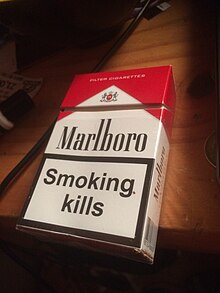This article has multiple issues. Please help
improve it or discuss these issues on the
talk page. (
Learn how and when to remove these template messages)
|


A warning label is a label attached to a product, or contained in a product's instruction manual, warning the user about risks associated with its use, and may include restrictions by the manufacturer or seller on certain uses. [1] Most of them are placed to limit civil liability in lawsuits against the item's manufacturer or seller (see product liability). [2] [3] That sometimes results in labels which for some people seem to state the obvious.
Government regulation
In the United States warning labels have been instituted under a number of different government organizations. For instance the Federal Food, Drug, and Cosmetic Act of 1938. [4] Cigarettes were not required to have warning labels in the United States until in 1965 Congress passed the Federal Cigarette Labeling and Advertising Act (FCLAA). [5] Other organizations that create label standards in the U.S. the Occupational Safety and Health Administration (OSHA) and American National Standards Institute (ANSI) govern their use. The U.S. organizations pull from international organizations such as the Globally Harmonized System of Classification and Labelling of Chemicals and the International Standards Organization (ISO)
In the EEA, a product containing hazardous mixtures must have a Unique formula identifier (UFI) code. This is not a warning label per se, but a code that helps poison control centres identify the exact formula of the hazardous product.
Hazard level warning labels
In the US or elsewhere:
| Term | Hazard | Meaning | Usage |
|---|---|---|---|
| Danger! | Highest level | Indicates severe injury or death certain to occur if not avoided. | Reserved for the most severe situations, often accompanied by symbols or pictograms that are universally recognized to quickly convey the risks involved even if the language is not recognized by the viewer. |
| Warning! | Medium level | There is a potential hazard that could result in serious injury or death but is less immediate or severe or probable than those marked with "Danger." | Signals a need for caution and awareness of the potential risks, and, like "Danger," is often paired with symbols to facilitate quick recognition. |
| Caution! | Lowest level | There is a potential hazard that could result in minor or moderate injury, or there is a risk of property damage. | Used in situations where the risks do not typically result in serious injury or death but where attention and care are still required. It advises individuals to proceed with caution to prevent accidents. |
The terms Danger, Warning and Caution are regulated by the Globally Harmonized System of Classification and Labelling of Chemicals (GHS) ANSI Z535. Graphic symbols are regulated by ISO 7010.
Abnormal warning labels
Some companies hold competitions to find particularly strange warning labels, such as Michigan Lawsuit Abuse Watch's "Wacky Warning Labels" contest. [6] [7] [8] The 2004 winner was "If you do not understand, or cannot read, all directions, cautions and warnings, do not use this product." [6]
While many safe products intended for human consumption may require warning labels due to the health risks associated with using them, it is only tobacco products that have strongly worded warnings on their health risks.[ citation needed]
See also
- Alcohol packaging warning messages
- California Proposition 65 (1986)
- black box warnings mandated by US Food and Drug Administration
- Tobacco packaging warning messages
- Warning Labels for Soft Drinks
- History of warning labels in the US
- Hazard symbol
References
- ^ Wogalter, Michael S. (2006). "Introduction". In Wogalter, Michael S. (ed.). Handbook of warnings. Mahwah, New Jersey: Lawrence Erlbaum Associates. ISBN 978-0-8058-4724-6.
- ^ Egilman, D. & Bohme, S. R. (2006). "Purposes and Scope of Warnings". In Wogalter, Michael S. (ed.). Handbook of warnings. Mahwah, New Jersey: Lawrence Erlbaum Associates. ISBN 978-0-8058-4724-6.
- ^ Khoury, Clarke E. (1989). "Warning Labels May Be Hazardous to Your Health: Common-Law and Statutory Responses to Alcoholic Beverage Manufacturers' Duty to Warn". Cornell Law Review. 75: 158–188.
- ^ Federal Food, Drug, & Cosmetic Act, Pub. L. No. 75-717, 52 Stat. 1040 (1938) (codified as amended at 21 U.S.C. §§ 301-99 (2006))
- ^ Federal Cigarette Labeling and Advertising Act, Pub. L. No. 89-92, 79 Stat. 282 (1965) (codified as amended at 15 U.S.C. §§ 1331-40 (1970)).
- ^ a b "M-Law Announces Winners Of Seventh Annual Wacky Warning Label Contest". 2004. Archived from the original on 9 June 2004.
- ^ ""Danger: Avoid Death" Warning Wins Top Prize In M-Law's Eleventh Annual Wacky Warning Label Contest". 2011. Archived from the original on 24 April 2013.
- ^ Nelson, Brett & Finneran, Katy (23 February 2011). "Dumbest Warning Labels". Forbes. Archived from the original on 25 February 2011.
External links